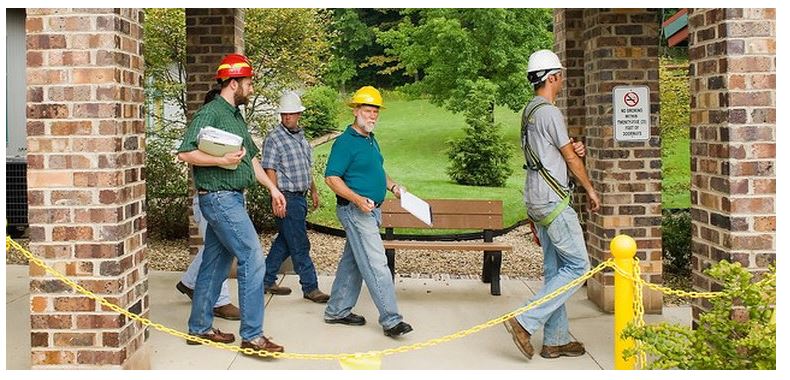WASHINGTON – President Trump will unveil his long-awaited infrastructure proposal Monday to shift $200 billion over the next decade from other federal programs to pave the way for $1.5 trillion for roads, bridges, waterways and railways. Trump’s approach is to let Congress negotiate the details. His four objectives are to stimulate new investment, streamline federal permitting, invest in rural projects and improve the workforce, according to four senior administration officials who briefed reporters Saturday. Tell me more >>>
Ohio County Files Breach-of-Contract Lawsuit Against Surety, Excavating Contractor
Mahoning County commissioners have filed a lawsuit which claims a local excavating company and a Cincinnati bonding company have failed to meet the terms of their contracts. The lawsuit filed Monday in common pleas court claims X-Press Underground Inc. of Petersburg failed to complete its $418,075 contract to replace a pump station in New Middletown. A pump station contains pumps and equipment for moving sewage from a lower to a higher elevation to a treatment plant. The commissioners voted to terminate their contract with X-Press in October. Read what happened next >>>
Contractors Need to Know Pros and Cons of Direct Payments to Subs
Main contractor Carillion’s entry into liquidation has resulted in many employers seeking to establish relationships with subcontractors, under which they will be paid directly in order to stay on site and finish the relevant project. On the face of it, this seems like an attractive solution, and may leave some employers wondering why they didn’t procure their projects by construction management in the first place. However, establishing direct relations is not without risks, and requires safeguards for employers and subcontractors alike. Those are set out in the last section of this article, but it is important to understand the pitfalls, particularly of direct payment, first. Read about direct payment pitfalls >>>
Subcontractors: Managing Cash Flow Requires Open Communication
Very few construction projects happen without subcontractors. Some general contractors self-perform all or a portion of the construction work, but, most often, major and minor trades contribute the lion’s share of labor and materials. Read the article >>>
Almost-Completed VA Hospital Project in Colorado More Than $1B Over Budget
The Aurora hospital has been a thorn in the VA’s side for years. The agency will miss the original completion date by four years, but the facility helped catalyze Congress’ decision to put the Army Corps of Engineers in charge of any VA construction project expected to cost $100 million or more. Read about it here >>>
Workers’ Compensation Rate Calculation New Benchmark for Contractors’ Qualification To Bid
A complicated calculation for determining workers compensation premiums has evolved into a do-or-die benchmark on whether contractors are qualified to bid on many jobs, and some say that’s not fair, especially for smaller contractors. It’s called the experience modification rate (EMR), and it’s based on previous workers’ comp claims versus payroll and other factors. The rate can lead to a reduction or increase in a company’s workers’ comp premiums. But over the years, the rate has come to mean much more in the construction industry, where the number has often become the final word on a construction company’s safety practices. Tell me more >>>
Subs On Athletic Apparel Company’s Expansion Seek Recourse For Pay Disputes
Five years in, the ambitious and ever-evolving headquarters expansion at Nike is finally producing the first completed buildings. It’s also left a trail of angry subcontractors. The strikingly modernistic structures taking shape on Nike’s campus near Beaverton have proved difficult and time-consuming to build. Subcontractors and their lawyers claim in court filings the company and its general contractor, Hoffman Construction, have repeatedly modified or broadened the scope of the project while refusing to cover the extra costs. That includes completed work that was ripped out and redone, they say. Get the story here >>>
Resilient Structures, Infrastructure Among 2018’s Trends In Construction
After a robust 2017, commercial construction companies are anticipating an even stronger 2018, with the majority reporting they plan to expand their staffs, according to Dodge Data & Analytics. As professionals seek to map out 2018 and beyond, there are a number of trends shaping the construction industry. Some are evolutions of past years, such as offsite construction and an increasing reliance on technology, and some trends are new, such as a focus on resiliency after the most damaging hurricane season on record and devastating fires in California. Read more here >>>
Court Denies Surety’s Move To Dismiss Case, Finds That Venue Was Proper
Use of the Word “in” Indicates Geography; Use of the Word “of” Indicates Sovereignty: Federal District Court in Maryland Holds That Venue Is Proper in Federal Court in Maryland Where Forum Selection Clause Requires Action to be Brought “In the District or County” Where the Prime Contractor Is Located. Tell me more >>>
Clear Contract Language Is Key When GCs Share Risk Of Nonpayment With Subs
Every contract involves the risk of insolvency, and every construction subcontract involves the risk of the owner/developer failing to make the payments that the contractor intends to use to pay its subcontractors. Frequently, general contractors seek to shift this risk onto their subcontractors through the use of clauses which describe payment from the owner to the contractor as a condition precedent to payment to the subcontractor. Simply put, when the contractor is successful in shifting the risk to the subcontractor, the clause is known as “Pay-If-Paid”. If contract language is not sufficient to transfer the risk, the clause is viewed as “Pay-When-Paid”. A Pay-When-Paid clause merely defers the timing of the payment due to the subcontractor until the contractor has …










